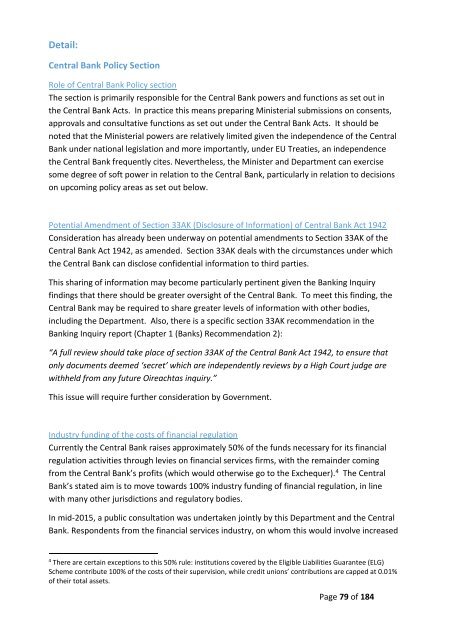Minister’s Brief
20160229%20Minister%20for%20Finance%20Brief%20redacted%20web
20160229%20Minister%20for%20Finance%20Brief%20redacted%20web
You also want an ePaper? Increase the reach of your titles
YUMPU automatically turns print PDFs into web optimized ePapers that Google loves.
Detail:<br />
Central Bank Policy Section<br />
Role of Central Bank Policy section<br />
The section is primarily responsible for the Central Bank powers and functions as set out in<br />
the Central Bank Acts. In practice this means preparing Ministerial submissions on consents,<br />
approvals and consultative functions as set out under the Central Bank Acts. It should be<br />
noted that the Ministerial powers are relatively limited given the independence of the Central<br />
Bank under national legislation and more importantly, under EU Treaties, an independence<br />
the Central Bank frequently cites. Nevertheless, the Minister and Department can exercise<br />
some degree of soft power in relation to the Central Bank, particularly in relation to decisions<br />
on upcoming policy areas as set out below.<br />
Potential Amendment of Section 33AK (Disclosure of Information) of Central Bank Act 1942<br />
Consideration has already been underway on potential amendments to Section 33AK of the<br />
Central Bank Act 1942, as amended. Section 33AK deals with the circumstances under which<br />
the Central Bank can disclose confidential information to third parties.<br />
This sharing of information may become particularly pertinent given the Banking Inquiry<br />
findings that there should be greater oversight of the Central Bank. To meet this finding, the<br />
Central Bank may be required to share greater levels of information with other bodies,<br />
including the Department. Also, there is a specific section 33AK recommendation in the<br />
Banking Inquiry report (Chapter 1 (Banks) Recommendation 2):<br />
“A full review should take place of section 33AK of the Central Bank Act 1942, to ensure that<br />
only documents deemed ‘secret’ which are independently reviews by a High Court judge are<br />
withheld from any future Oireachtas inquiry.”<br />
This issue will require further consideration by Government.<br />
Industry funding of the costs of financial regulation<br />
Currently the Central Bank raises approximately 50% of the funds necessary for its financial<br />
regulation activities through levies on financial services firms, with the remainder coming<br />
from the Central Bank’s profits (which would otherwise go to the Exchequer). 4 The Central<br />
Bank’s stated aim is to move towards 100% industry funding of financial regulation, in line<br />
with many other jurisdictions and regulatory bodies.<br />
In mid-2015, a public consultation was undertaken jointly by this Department and the Central<br />
Bank. Respondents from the financial services industry, on whom this would involve increased<br />
4<br />
There are certain exceptions to this 50% rule: institutions covered by the Eligible Liabilities Guarantee (ELG)<br />
Scheme contribute 100% of the costs of their supervision, while credit unions’ contributions are capped at 0.01%<br />
of their total assets.<br />
Page 79 of 184


